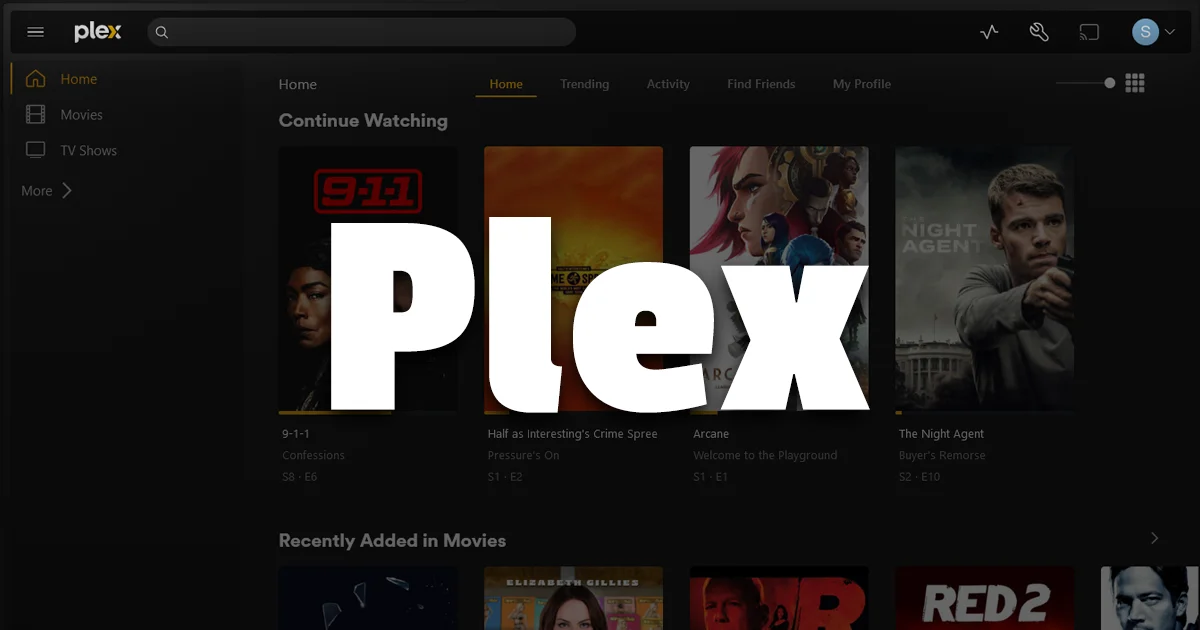Plex - Selfhosted Media Server
Plex (Plex Media Server) is free software that allows users to create a client–server for movies, television shows, and music. Free Plex accounts can share personal media libraries among a user’s own collection of devices or with friends. Plex Media Server organizes movie and television content and adds posters, plot summaries, cast and crew lists, technical details, critical reviews, and subtitles.
Since this uses media from my NAS i have simply decided to run this as a Docker Container on UnRAID on my NAS instead of having it as part of my kubernetes cluster to remove the need to access the NAS media remotely
Kubernetes Manifest
1
2
3
4
5
6
7
8
9
10
11
12
13
14
15
16
17
18
19
20
21
22
23
24
25
26
27
28
29
30
31
32
33
34
35
36
37
38
39
40
41
42
43
44
45
46
47
48
49
50
51
52
53
54
55
56
57
58
59
60
61
62
63
64
65
66
67
68
69
70
71
72
73
74
75
76
77
78
79
80
81
82
83
84
85
86
87
88
89
90
91
92
93
94
95
96
97
98
99
100
101
102
103
104
105
106
107
108
109
110
111
112
113
114
115
116
117
118
119
120
121
122
123
124
125
---
apiVersion: apps/v1
kind: Deployment
metadata:
labels:
app: plex
app.kubernetes.io/instance: plex
app.kubernetes.io/name: plex
name: plex
namespace: plex
spec:
replicas: 1
strategy:
type: Recreate
selector:
matchLabels:
app: plex
template:
metadata:
labels:
app: plex
app.kubernetes.io/name: plex
spec:
nodeSelector:
nas: "true"
containers:
- image: linuxserver/plex
name: plex
ports:
- containerPort: 32400
hostPort: 32400
protocol: TCP
- containerPort: 32400
hostPort: 32400
protocol: UDP
- containerPort: 32469
hostPort: 32469
protocol: TCP
- containerPort: 32469
hostPort: 32469
protocol: UDP
- containerPort: 5353
hostPort: 5353
protocol: UDP
- containerPort: 1900
hostPort: 1900
protocol: UDP
env:
- name: TZ
value: Europe/London
- name: PLEX_CLAIM
value: [REDACTED]
- name: VERSION
value: docker
volumeMounts:
- mountPath: "/media"
name: smb
- mountPath: "/config"
name: config
- mountPath: "/transcode"
name: smb
subPath: .transcode
- mountPath: /dev/dri
name: dri
securityContext:
privileged: true
volumes:
- name: smb
persistentVolumeClaim:
claimName: pvc-plex-smb
- name: config
persistentVolumeClaim:
claimName: plex
- name: dri
hostPath:
path: /dev/dri
---
apiVersion: v1
kind: Service
metadata:
labels:
app: plex
name: plex
namespace: plex
spec:
ports:
- name: web-tcp
port: 32400
protocol: TCP
targetPort: 32400
selector:
app: plex
---
apiVersion: traefik.containo.us/v1alpha1
kind: IngressRoute
metadata:
name: plex
namespace: plex
annotations:
kubernetes.io/ingress.class: traefik-external
gethomepage.dev/href: "https://plex.f9.casa"
gethomepage.dev/enabled: "true"
gethomepage.dev/description: Media Server
gethomepage.dev/group: Media
gethomepage.dev/icon: plex.png
gethomepage.dev/name: Plex
gethomepage.dev/widget.type: "plex"
gethomepage.dev/widget.url: "http://plex.plex:32400"
gethomepage.dev/widget.key: "[REDACTED]"
# gethomepage.dev/widget.fields: "['movies', 'tv', 'streams']"
spec:
entryPoints:
- websecure
routes:
- match: Host(`plex.f9.casa`)
kind: Rule
services:
- name: plex
port: 32400
middlewares:
- name: default-headers
namespace: default
tls:
secretName: f9-casa-tls
Docker Compose
Note that as I use Docker Swarm I am making use of https://github.com/allfro/device-mapping-manager to pass through dev’s to swarm containers by faking a volume, this container then detects that fake volume and maps it as a device
1
2
3
4
5
6
7
8
9
10
11
12
13
14
15
16
17
18
19
20
21
22
23
24
25
26
27
28
29
30
31
32
33
34
35
36
37
38
39
40
41
42
43
44
45
46
47
48
49
version: '3.9'
services:
plex:
image: lscr.io/linuxserver/plex:latest
hostname: plex
# privileged: true
networks:
- traefik-public
environment:
- PUID=1000
- PGID=1000
- TZ=Europe/London
- VERSION=docker
volumes:
- /srv/cephfs/docker/appdata/plex:/config
- /srv/media:/media
- /srv/media/.transcode:/transcode
- /srv/filmtv:/filmtv
- /dev/dri:/dev/dri
ports:
- 32400:32400
deploy:
labels:
- "traefik.enable=true"
- "traefik.http.routers.plex.rule=Host(`plex.f9.casa`)"
- "traefik.http.services.plex.loadbalancer.server.port=32400"
- "traefik.http.routers.plex.entrypoints=websecure"
- "traefik.http.routers.plex.tls=true"
- "traefik.http.routers.plex.tls.certresolver=letsencrypt"
- "traefik.http.services.plex.loadbalancer.healthcheck.path=/identity"
- homepage.group=Media
- homepage.name=Plex
- homepage.icon=plex.png
- homepage.href=https://plex.f9.casa
- homepage.description=Media server
- homepage.siteMonitor=http://plex:32400/identity
- homepage.widget.type=plex
- homepage.widget.url=http://plex:32400
- homepage.widget.key=[REDACTED]
- homepage.widget.fields=["movies", "tv", "streams"]
mode: replicated
placement:
constraints:
- node.labels.gpu == true
networks:
traefik-public:
external: true
